MARIANI’S
Virtual
Gourmet
AUGUST
28, 2016
NEWSLETTER
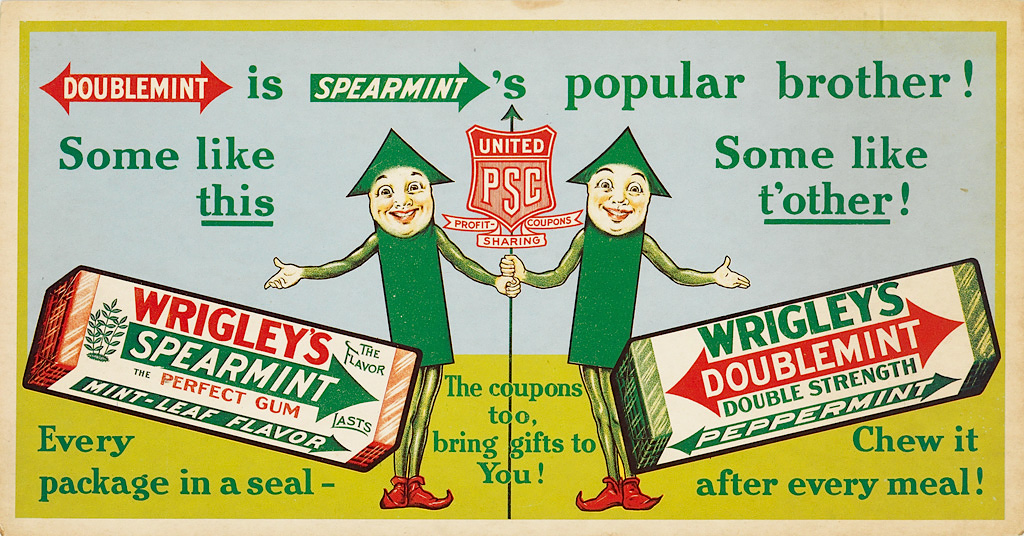
❖❖❖
IN THIS ISSUE
SOUTH OF NAPLES LIE
GREAT FOOD AND WINE
By John Mariani
NEW YORK CORNER
BEDFORD & CO
By John Mariani
NOTES FROM THE WINE CELLAR
ADELSHEIM VINEYARDS
By John Mariani
❖❖❖
SOUTH OF NAPLES LIE
GREAT FOOD AND WINE
By John Mariani
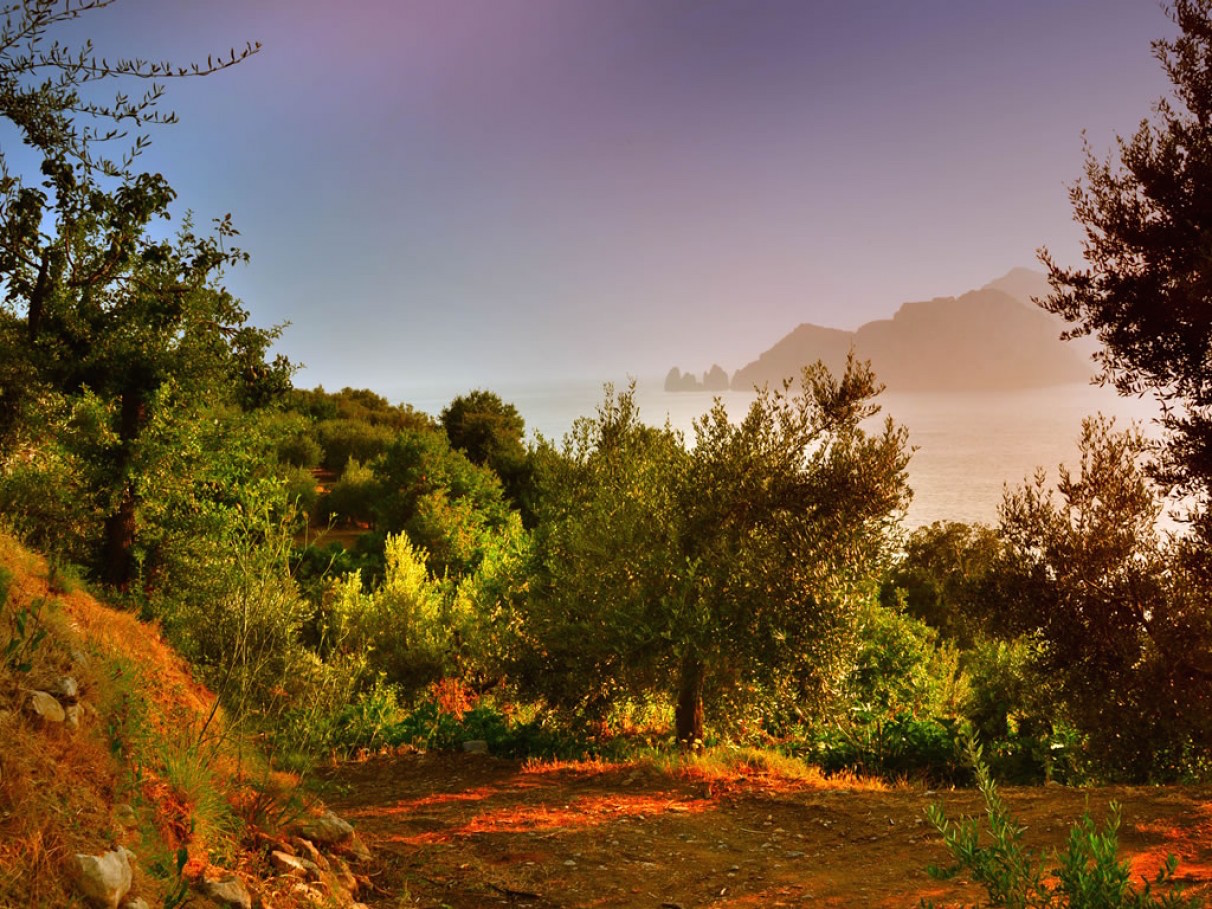
The view of the Bay of Naples from Don Alfonso's Farm
Before a
traveler embarks on the treacherously
winding and ridiculously narrow drive
along Italy’s Amalfi Coast, there are
towns and pleasures along the way just
south of Naples and before you get to
Sorrento, not least, of course, Mount
Vesuvius and the ruins of Pompeii. And
in the foothills of the volcano lies 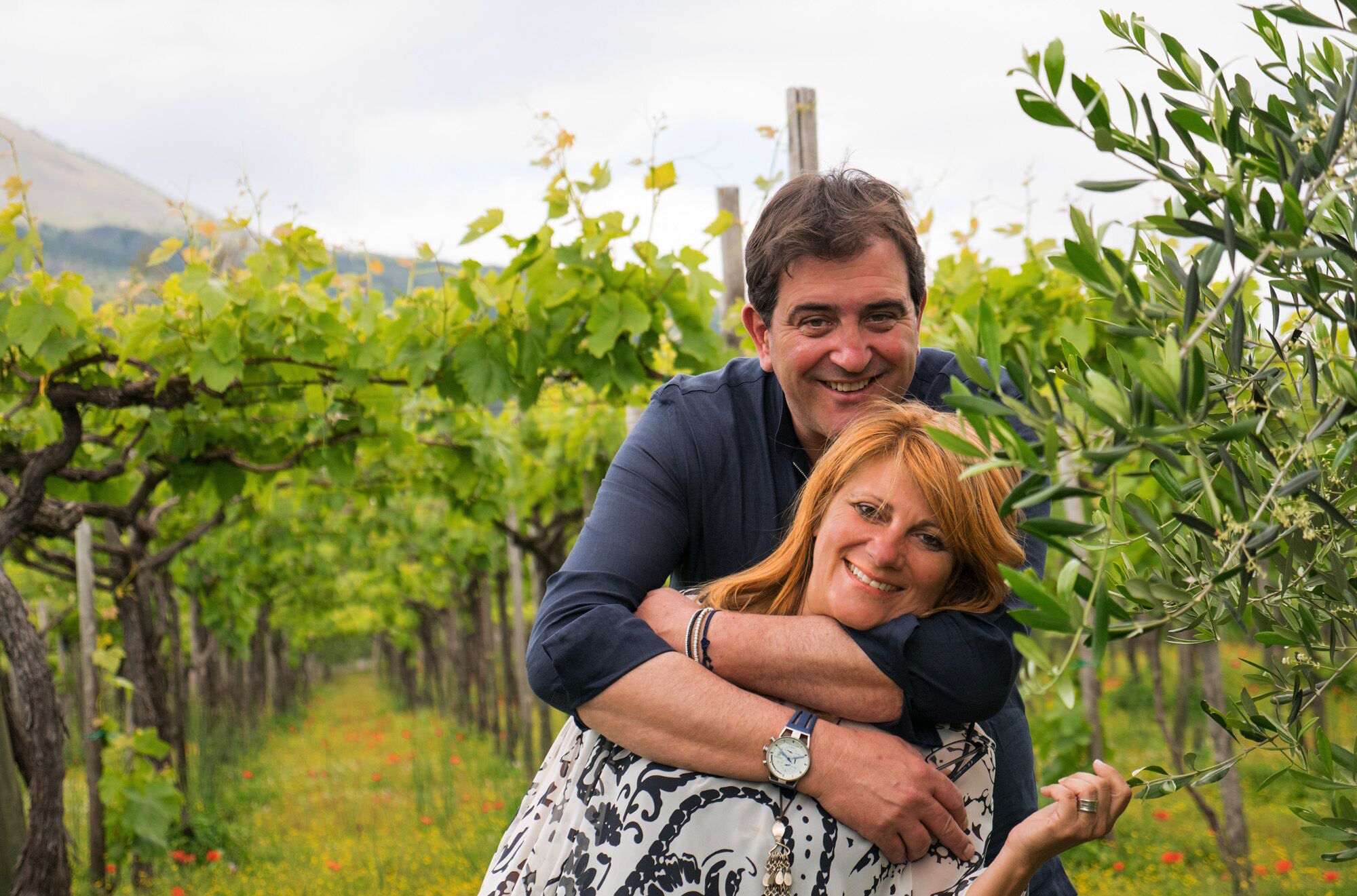 one
of the most enchanting attractions I
know of in Southern Italy: Cantina
del Vesuvio, where, on
30 acres of very rich volcanic soil,
Maurizio Russo and his partner, Esther
Grosso (left), produce
excellent wines and run a little
trattoria serving some of the best
local food in the area.
one
of the most enchanting attractions I
know of in Southern Italy: Cantina
del Vesuvio, where, on
30 acres of very rich volcanic soil,
Maurizio Russo and his partner, Esther
Grosso (left), produce
excellent wines and run a little
trattoria serving some of the best
local food in the area.
The winery was founded in 1949 by
Maurizio’s father, Giovanni, at a time when wine
was transported to Naples by horse-drawn wagons,
then sold to merchants who supplied the
restaurants and wine stores. Then, 18 years ago,
Maurizio began selling his products from the
winery itself, after improving their quality and
making his estate a tourist destination at the
base of Vesuvius.
And so you arrive—a
twenty-minute drive from the center of
Naples—among the cool green hills of Vesuvius. You
will be effusively met by Esther, whose
graciousness is exceeded only by her joy that you
have come to visit.
Maurizio, who is in the vineyards digging,
planting, trellising, and pruning, invariably
arrives and proudly shows off his winery.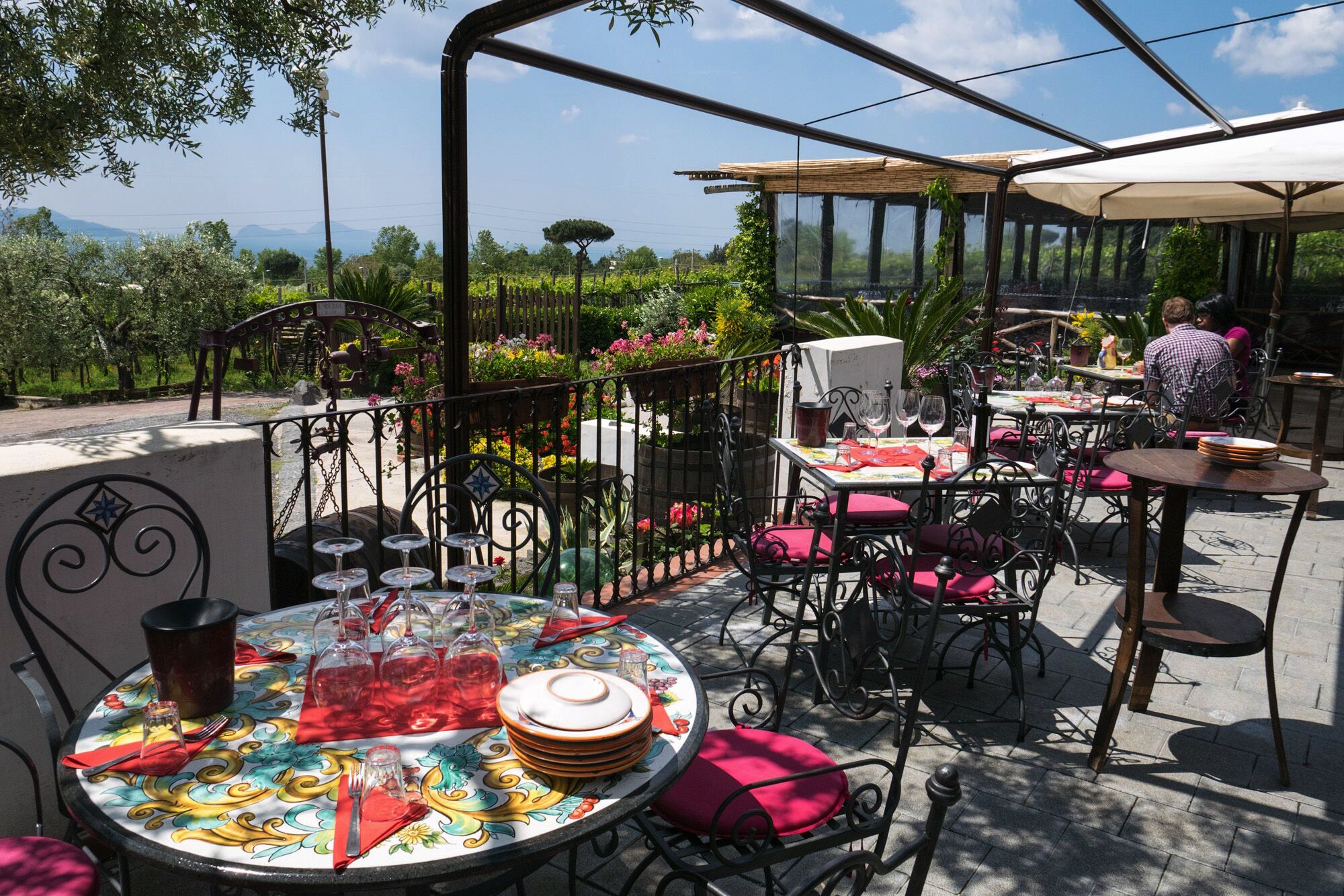
Then you sit either on the
leafy patio or in the rustic interior room, where
the moment you sit down, bottles of Lacryma
Christi bianco, Rosato, and Rosso wines, pitchers
of water and a lavish antipasto platter of
provolone and salami, local Casatiello bread, and
smoky bruschetta topped with heirloom Piennolo
tomatoes
are brought over.
Then
arrives a bottle of Lacryma Christi Riserva and a
platter of spaghetti tossed with a deep red tomato
sauce of such intensity that, unless you have
dined elsewhere in Campania, where the tomato
achieves unparalleled greatness, you will never
have tasted anything like it. Stick the bread into
the sauce, leave nothing behind. Finish this
supremely simple meal with a Napolitana torta di
pastiera made with sweetened ricotta,
candied fruit and boiled wheat berries, paired
with Capafresca Spumante Rosato and Acquavite di
Albicocche del Vesuvio. Nothing short of an eruption
on Mount Vesuvius could possibly affect your
bliss.
By then, with a languorous
smile of satisfaction on your face, you will be
powerless to resist going to the winery room and
buying Cantina del Vesuvio’s wines, their superb
olive oil, and perhaps one of the pretty
chicken-shaped pitchers. And, if you wish, you may
even take a cooking lesson here.
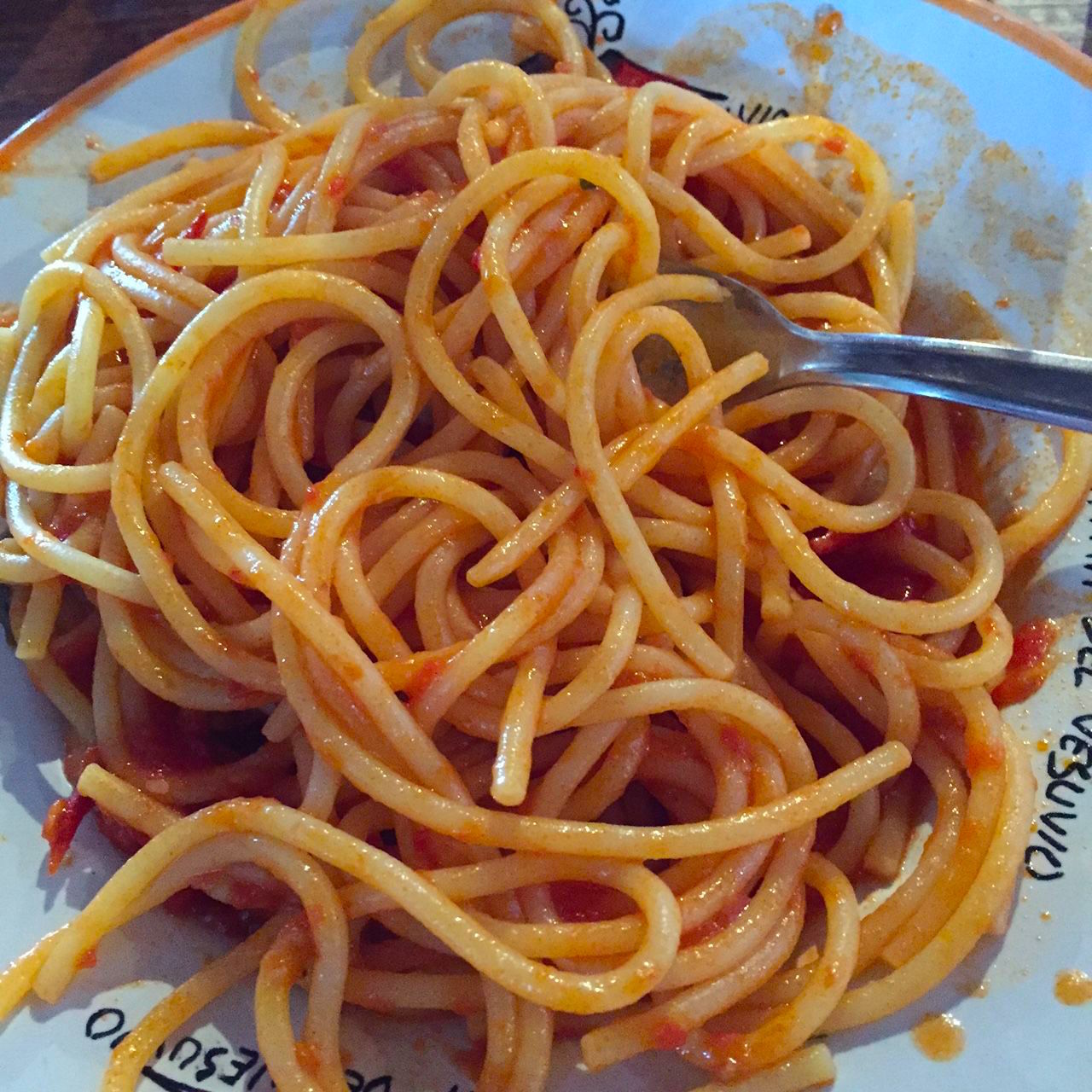 It
will have been a rare day, even in a region as
beautiful as Campania, and you will feel you’ve
made warm new friends, not just with Esther and
Maurizio and their staff—even perhaps with a
vineyard dog who ambles about the place—but with
the others from all over who shared the experience
with you that day.
It
will have been a rare day, even in a region as
beautiful as Campania, and you will feel you’ve
made warm new friends, not just with Esther and
Maurizio and their staff—even perhaps with a
vineyard dog who ambles about the place—but with
the others from all over who shared the experience
with you that day.
The shop at Cantina del Vesuvio is
open daily (closed Sundays in Jan. & Feb.).
Reservations should be made at +39 081 536
90 41 or through info@cantinadelvesuvio.it
From
the simple to the sublime is but a one-hour
drive. Set in the hill town of Sant’Agata sui
Due Golfi is the extraordinary Don Alfonso 1890,
which is not just one of the loveliest boutique
hotels in Italy but one of Europe’s very finest
restaurants, run by the redoubtable chef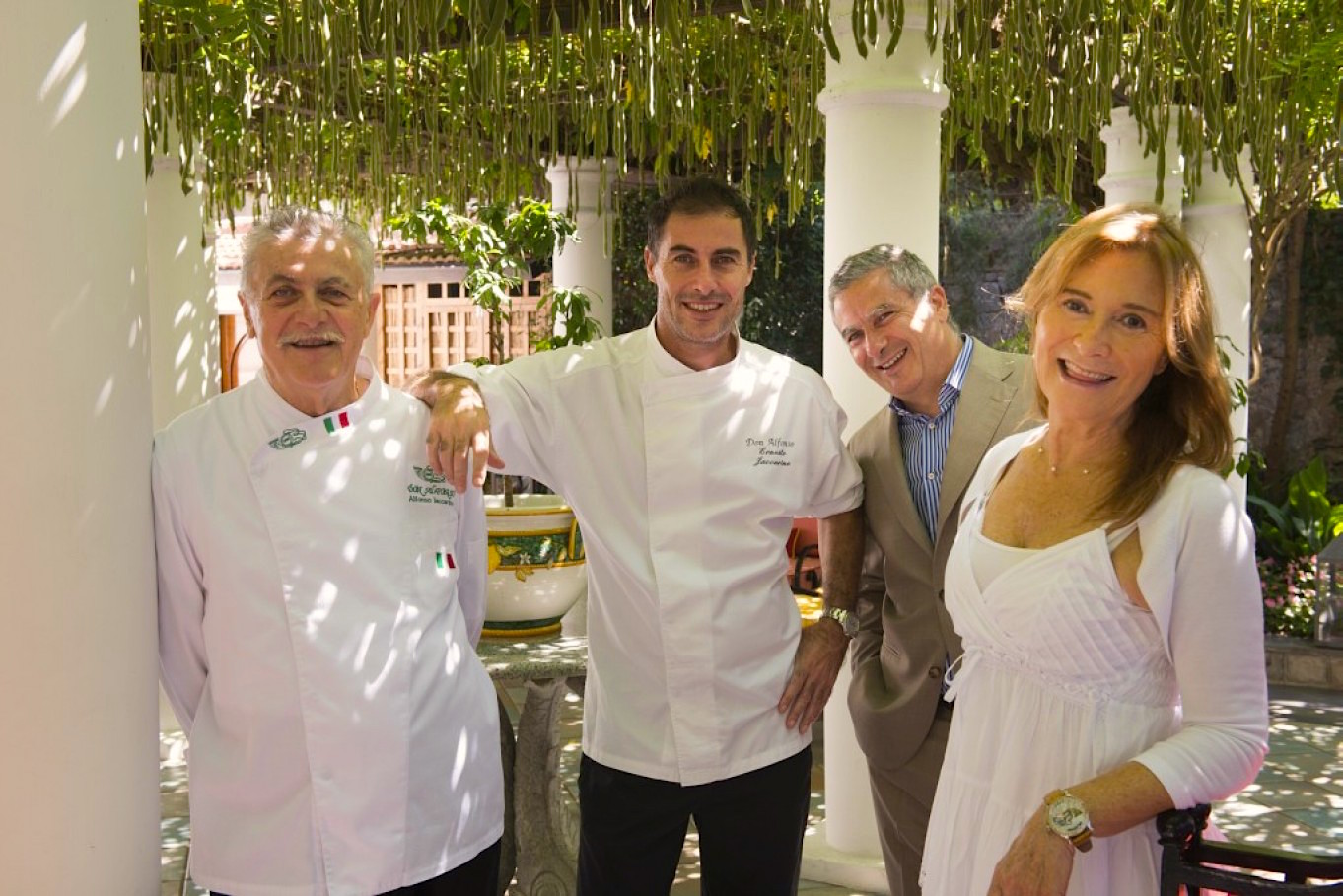 Don Alfonso Iaccarino
and his dear, charming wife, Livia, who have had
the hotel and ristorante
since 1982.
Don Alfonso Iaccarino
and his dear, charming wife, Livia, who have had
the hotel and ristorante
since 1982.
So removed is the
hotel from the rest of the area that the only
sounds you’ll hear are those of nature—birds,
bees, trickling water, wind in the trees. This was
once the reclusive residence of 19th century poet
Salvatore
Di
Giacomo, whose early fame soured into infamy after
he allied himself with the Fascisti.
Recent renovations
have brightened every room and suite with the
colors of the flowers and herbs they are named
for; the gardens have been amplified, the pool
refitted, and the reception area brought to a high
polish of classical elegance. The
dining room is as large as a chapel, with high,
airy ceilings, all in tonal variations of white
and pink, punctuated by modern artwork, with
impeccably set tables well spaced from one
another. The
only sound you hear is of guests murmuring their
approval of each dish’s presentation and taste,
right from the moment the variety of breads
arrives.
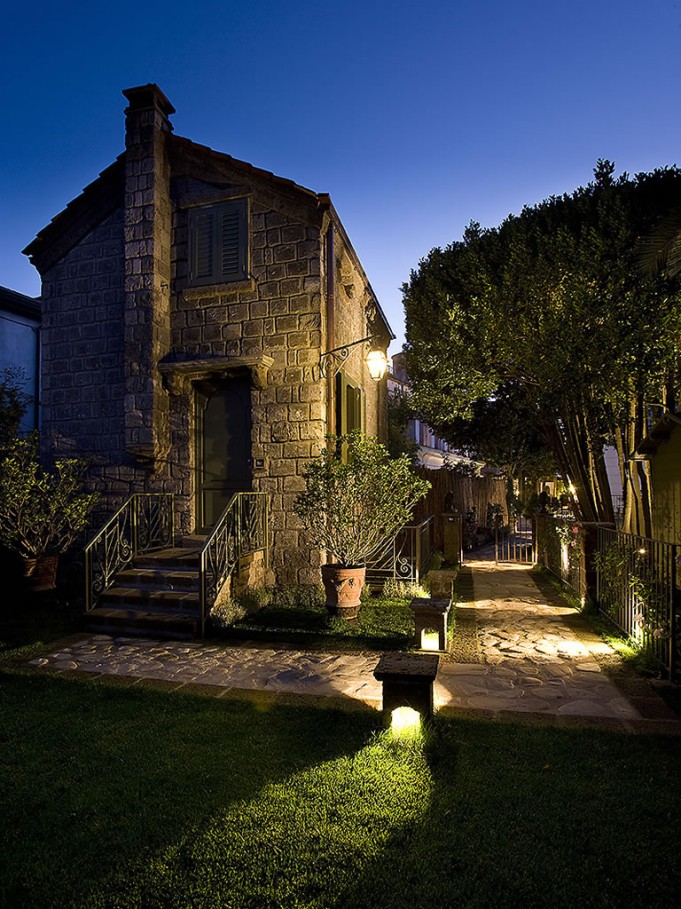
Don Alfonso is
clearly the maestro of the magnificently modern
kitchen (Livia oversees the million other details
of the estate with impeccable grace), and their
sons, Ernesto and Mario, and a brigade of 20 young
kitchen staff seem to regard him with as much awe
as they do affection. The cuisine here is
constantly evolving out of the traditions of
southern Italy, with most of the ingredients
plucked from the estate’s own seven-acre "Le
Peracciole" farm down the hillside, where they
make their own olive oil and raise some of their
own livestock and poultry.
The estate’s
wine cellar dates back six centuries, dug deep
into the volcanic rock and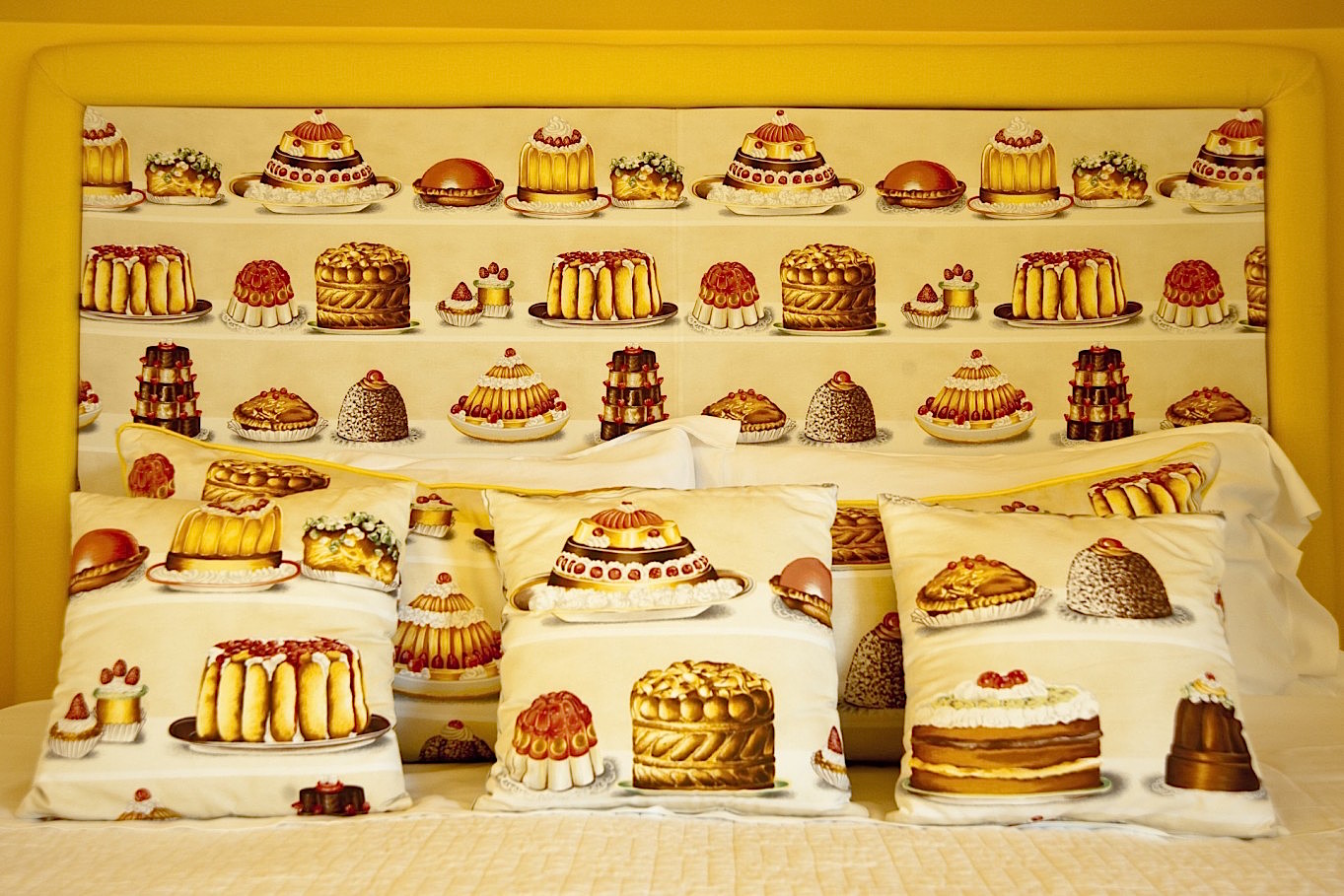 always maintained at
the same cool temperature, preserving a cache of
25,000 bottles and 1,300 labels; it would be
difficult to ask for any prestigious wine of the
world and not find it in several vintages in this
cellar (below).
Prices are remarkably fair, usually just above a
100% mark-up.
always maintained at
the same cool temperature, preserving a cache of
25,000 bottles and 1,300 labels; it would be
difficult to ask for any prestigious wine of the
world and not find it in several vintages in this
cellar (below).
Prices are remarkably fair, usually just above a
100% mark-up.
It is difficult to know where
to begin describing the menu at Don Alfonso, not
just because it is so extensive but because a mere
listing of its items would barely hint at their
creativity and exceptional balance of flavors and
textures without ever losing the essential flavor
of a dish. So
let me just try to describe some of the high
points of a multi-course sunlit lunch.
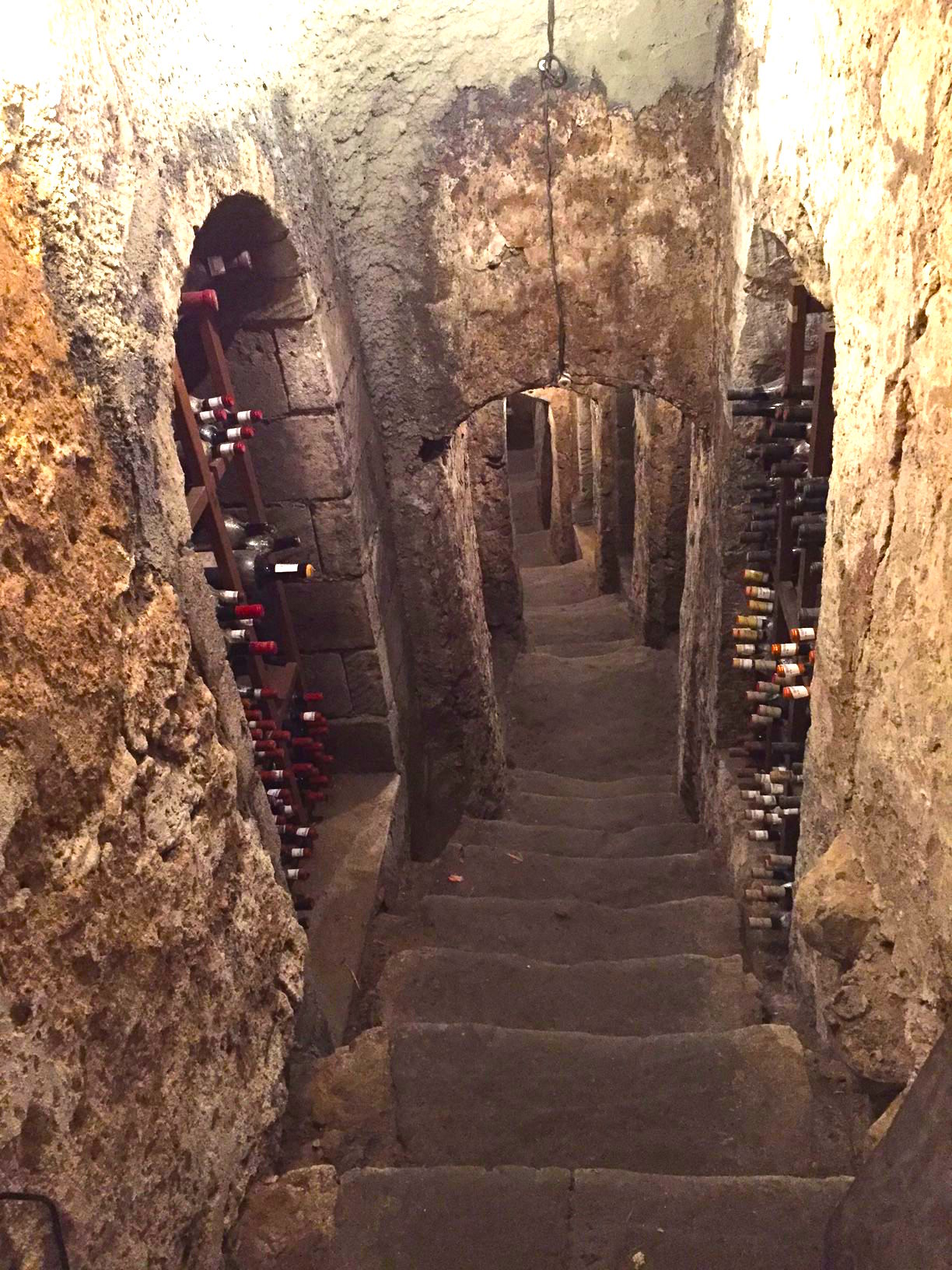 Having
managed not to eat all the breads offered, I
tucked into a kind of tempura-style lobster with
sweet and sour notes, cut by the acid of citrus
fruit, a dish I might have had in a fine
restaurant in Hong Kong. Next came a quivering baked
egg with cream-centered burrata
and shavings of black truffles that might serve as
an opulent breakfast.
Having
managed not to eat all the breads offered, I
tucked into a kind of tempura-style lobster with
sweet and sour notes, cut by the acid of citrus
fruit, a dish I might have had in a fine
restaurant in Hong Kong. Next came a quivering baked
egg with cream-centered burrata
and shavings of black truffles that might serve as
an opulent breakfast.
Very traditional here is the
potato gnocchi,
with just a touch of novelty in a sauce of creamed
smoked scamorza cheese and sweet cherry tomatoes.
Then came marvelously tender and nicely fatted
lamb with minced Mediterranean herbs and a subtle
aïoli. A
selection of local cheeses with honey from Le
Peracciole followed, then an array of desserts
that included baba with a Marsala-whipped
zabaglione and raspberry jelly; a “concert of
lemon,” composed of one of those big lemons of the
area that is hollowed out then filled with a lush
pastry cream topped with a netting of caramelized
lemon and a little lemon-scented beignet on the
side. 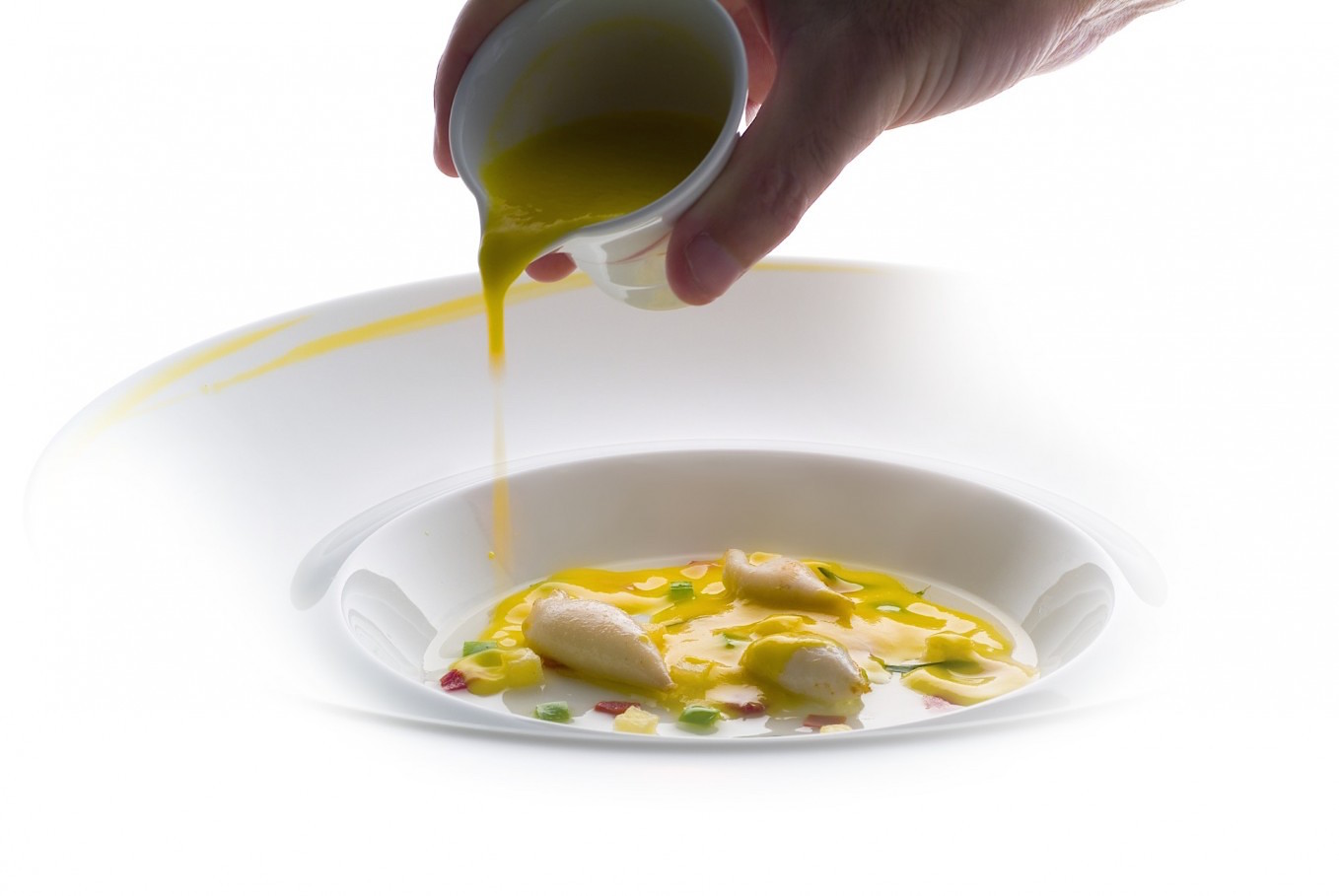
Extremely fragile sfogliatelle
pastry came perfumed with vanilla and cinnamon,
while a pastiera
soufflé made of ricotta and wheat was made
even richer with spiced honey ice cream.
There
were more sweets, including a pastel-colored
selection of macarons, bon bons, cookies and
chocolates, espresso elegantly served, and other
small touches that make a Don Alfonso meal so
indelible. After dinner you’ll want to stroll the
leafy grounds—you could cover the whole town in
about a two minutes’ walk—sit by the pool and sip
a grappa, or just retire to your room and watch
the stars peek from behind the clouds above the
Bay of Naples.
You’ll sleep well and you’ll sleep late.
❖❖❖
By John Mariani
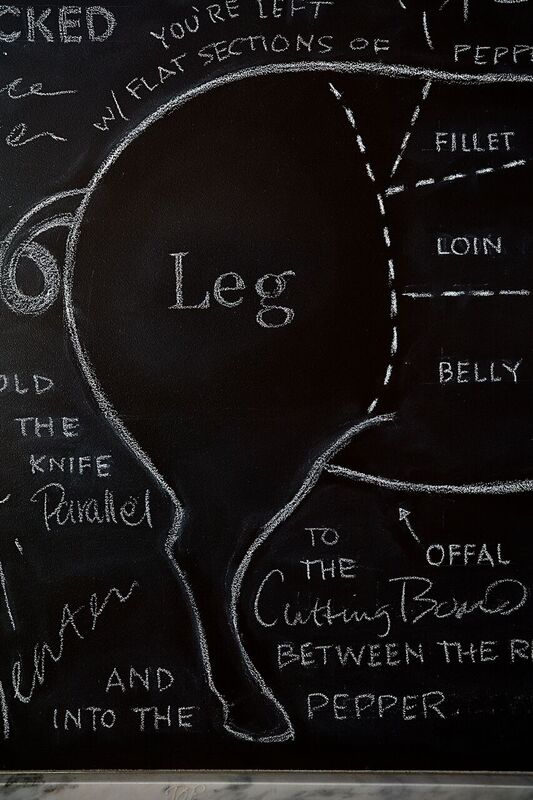 BEDFORD
& CO
BEDFORD
& CO118 East 40th Street (near Lexington Avenue)
212-634-4040
bedfordandco.com
No
one ever accused John DeLucie of not being a
first-rate chef in the NYC American style. He
first burst upon the scene at Graydon Carter’s
way-too-trendy Waverly Inn, then went out on his
own with partners in the Crown Group, opening
American grill restaurants up and down Manhattan
until the ceiling fell in on them. You
can Google the reasons for the group’s collapse
in the NY
Post, but DeLucie is nothing if not
resourceful, so it’s good to find him back at
the stoves, since February, at Bedford & Co.
in the Renwick Hotel.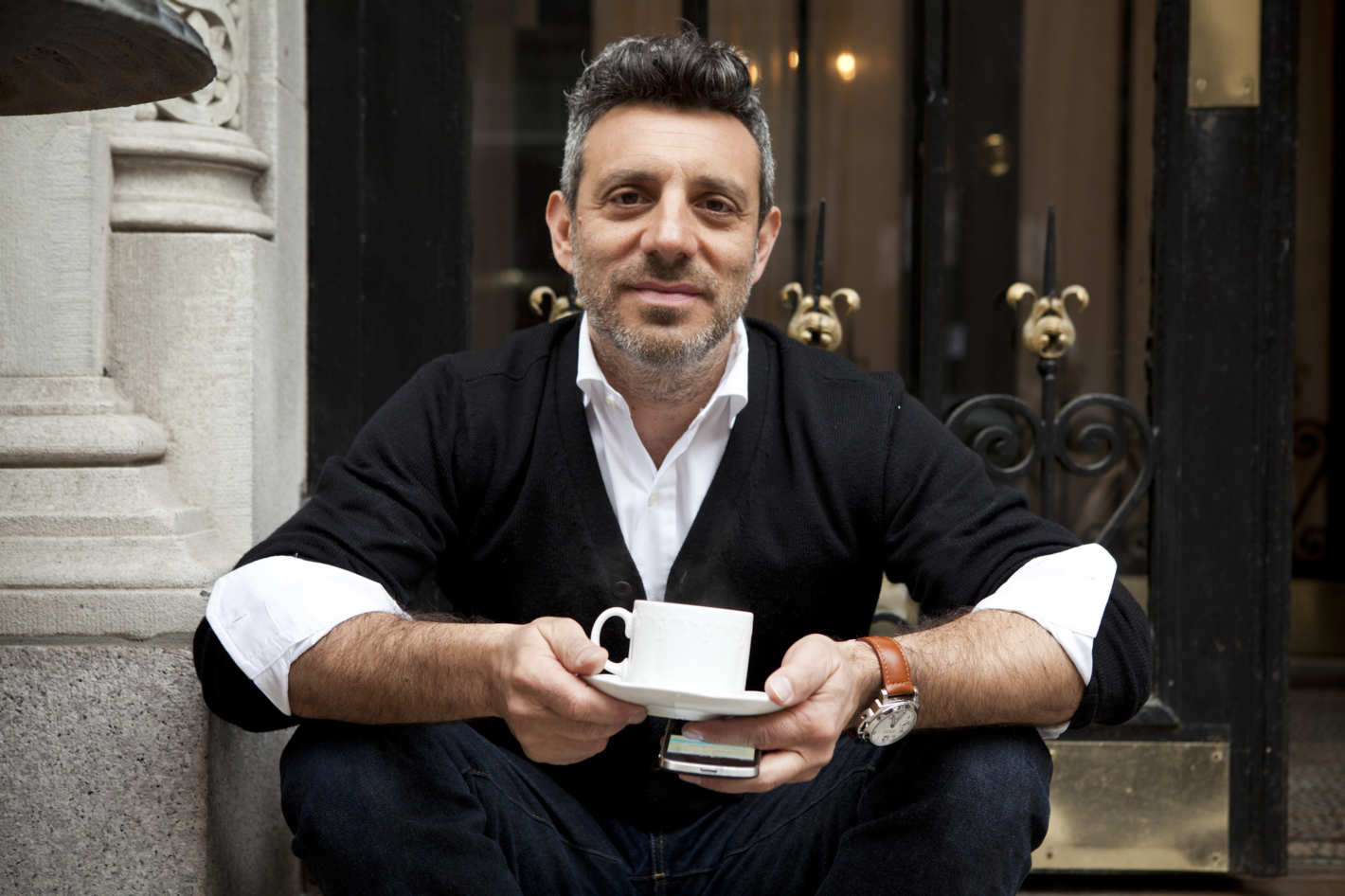
DeLucie’s background, which
includes an Italian
grandfather who owned a fruit and vegetable market
and a job chopping 40-pound bags of onions in the
back room of Dean & DeLuca, led to culinary
school, the obligatory grand tour of Europe, and a
job at the innovative Arizona 206 in NYC, then as
chef de cuisine at the seafood restaurant
Oceana.
The Renwick Hotel has its own
NYC history, with a long list of littérateur
guests like John Steinbeck, Thomas Mann and F.
Scott Fitzgerald; the name Bedford & Co.
refers to the hotel’s original name in those days.
Featured prominently within
sight of the small dining room is a wood-burning
open grill of a kind you’ll find in Argentina,
where meat, meat and more meat pretty much covers
the menu. (Stacked split logs make for a
decorative wall.)
DeLucie, with chef de cuisine Justin
Neubeck, puts
that grill to good use for a wider variety of
foods, from octopus to broccolini.
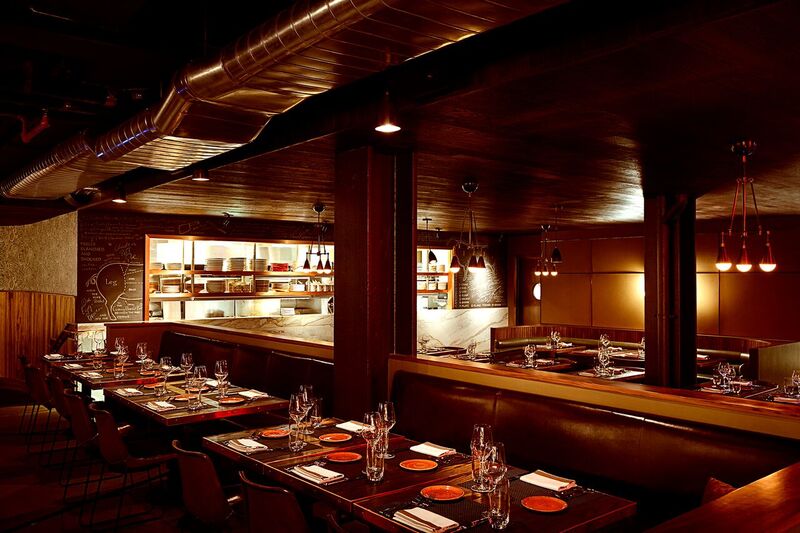 The tavern-like room is windowless
and low-lighted, largely done in dark wood that
could use brightening, not least the dark brown
tables with black placemats on them. The
sound level is fine for conversation, and the
crowd at the adjacent bar does not intrude. The
service staff, however, seriously needs to get its
timing down.
The tavern-like room is windowless
and low-lighted, largely done in dark wood that
could use brightening, not least the dark brown
tables with black placemats on them. The
sound level is fine for conversation, and the
crowd at the adjacent bar does not intrude. The
service staff, however, seriously needs to get its
timing down.
The
menu has sections of small plates, pastas, mains
and large formats, this last containing a massive
two-pound, 28-day dry-aged ribeye embellished with
lardo fat,
roasted garlic and watercress ($125), which can
easily feed three people. Right
now among the first courses is a delicious late
summer chilled corn soup perked up with marinated
mushrooms, yellow chili and toasted corn ($14). Not
pretty but quite good were the heads-on shrimp
with grains and a shellfish jus
($21). Portuguese octopus is now
ubiquitous in NYC, but the 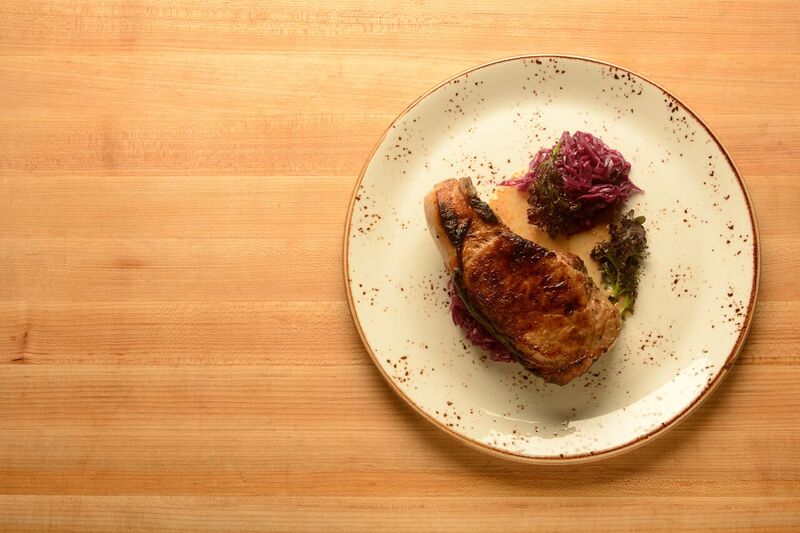 wood-grill here does its
fiery work, sided by a cucumber chili and a squid
ink vinaigrette ($19), marred only by too much
salt that night.
wood-grill here does its
fiery work, sided by a cucumber chili and a squid
ink vinaigrette ($19), marred only by too much
salt that night.
DeLucie has always been a
master of fresh pastas, and every one we tried was
perfectly cooked, spicily sauced and always with a
little unexpected lagniappe, like the pistachio
and merguez sausage and ricotta salata
with the spaghetti ($21); the kale and walnuts
with whole grain reginetti
($19); and house-cured pancetta,
green garlic and fennel with rigatoni
($21).
I’m always reading about
ultra-crisp chicken and am usually so
disappointed, but DeLucie’s dexterity with the
grill makes his chicken under a brick (right), with
asparagus, marinated mushroom and asparagus purée
($24), the real deal; rarely have I bitten into a
skin so crisp and buttery, with oozing succulence
in the meat underneath. A leg of Colorado lamb (well
priced at $28) comes with charred lettuce,
Moroccan olives and a sour cherry jus.
Perfectly charred, rosy-red steaks (below) have
always been among DeLucie's most laudable items on
his menus.
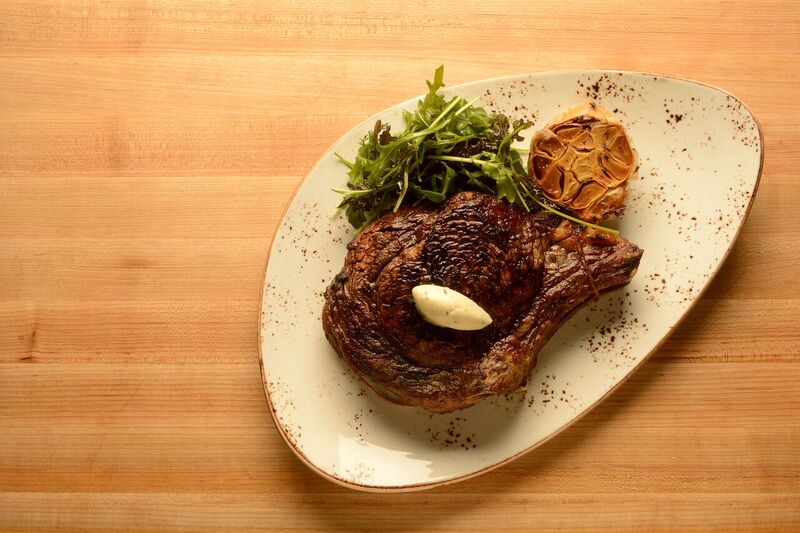 By all means
have those broccolini, but don’t miss the
herb-infused fries to be dipped into a rich
Béarnaise.
By all means
have those broccolini, but don’t miss the
herb-infused fries to be dipped into a rich
Béarnaise.
Pastry chef Fatmah Canty puts
her own twist on American favorites, like a
cheesecake in a jar with vanilla, house-made
Graham crackers and Bing cherries ($10); a rye
brownie with sea salt, candied walnuts and
luscious vanilla gelato ($10); a stone fruit crostata
with black pepper gelato
($12);
and lemon buttermilk pannacotta
with a rhubarb-strawberry compote ($11).
Bedford
& Co.’s wine list, overseen by Sarah Tracey,
will not win prizes for size, but might for being
so well selected to go with DeLucie’s food. But
prices are a little hard to swallow when a bottle
of Mionetto Prosecco goes for $9 in the store and
$12 a glass at the restaurant. And you
can find Livio Felluga Pinot Grigio for under $20
a bottle that will cost you $78 here.
I’m glad to see DeLucie back in
his chef’s whites and looking happy. He’s not a
guy you’d want to keep out of the kitchen for
long; he’s got too much to offer.
Bedford
& Co is open for breakfast, lunch and
dinner, as well as brunch on weekends.
❖❖❖
By John Mariani
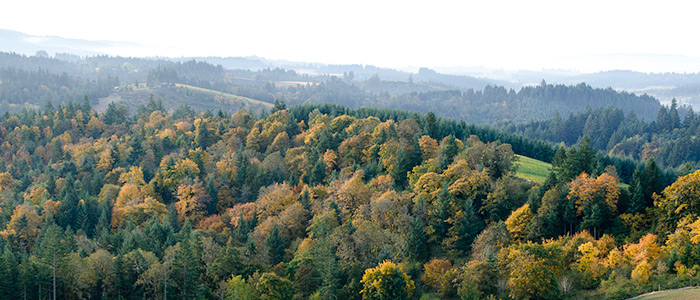
As someone who has enjoyed
Oregon wines over the past few decades, I have
to remind myself that the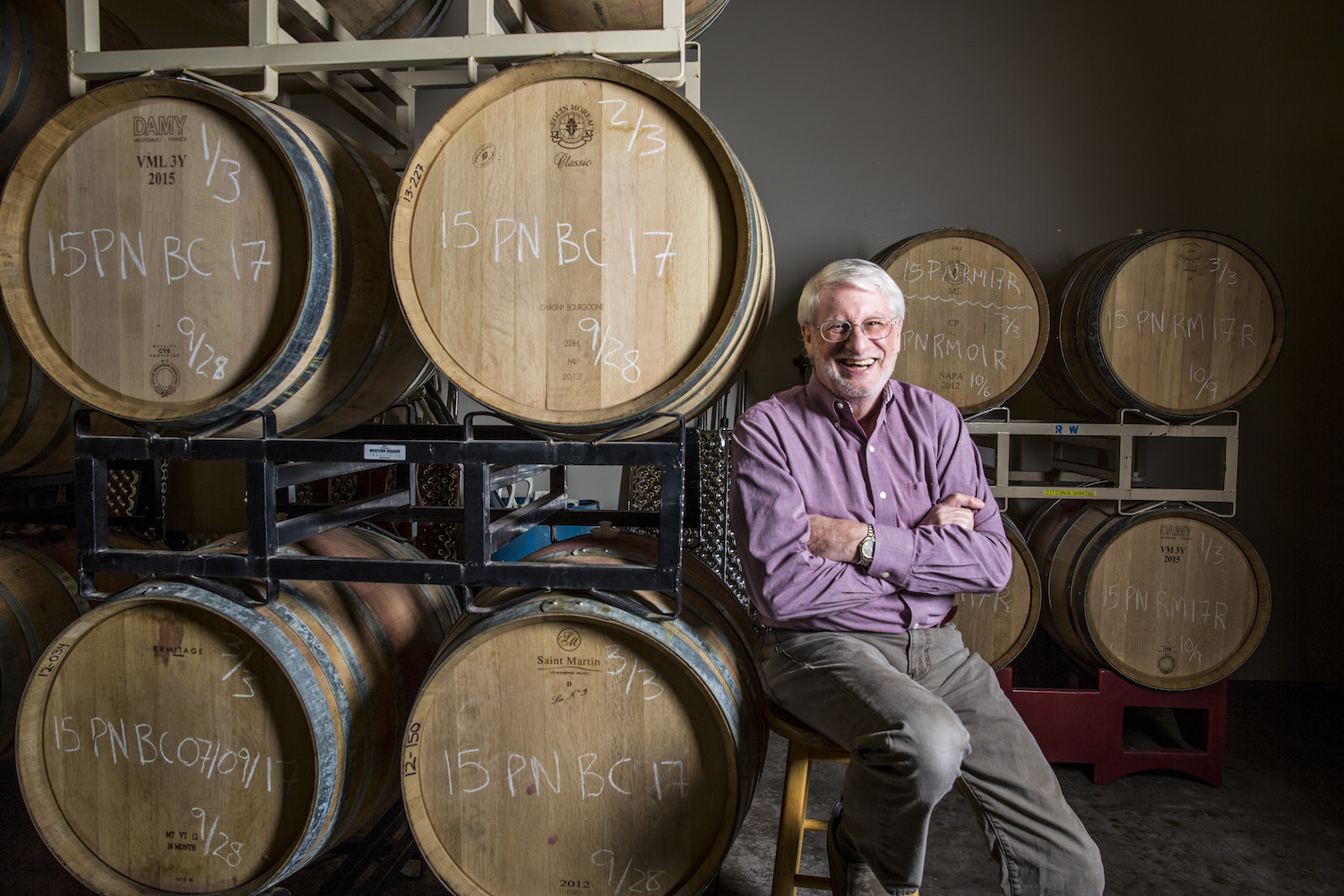 industry is still
going through adolescence compared with states
like New York and California, whose vinous
histories date back hundreds of years. There
had been plantings in Oregon as early as the
1860s and a small wine industry, largely
producing fruit wines, burgeoned just before
Prohibition shut it down in 1919.
industry is still
going through adolescence compared with states
like New York and California, whose vinous
histories date back hundreds of years. There
had been plantings in Oregon as early as the
1860s and a small wine industry, largely
producing fruit wines, burgeoned just before
Prohibition shut it down in 1919.
But it took decades for wine
production to resume after Prohibition ended in
1933, and it amounted to little in the post-war
years, when California’s wine industry blossomed,
then flourished in the 1960s. “We really started
from zero,” says David Adelsheim (left), who
with his wife, Ginny, purchased a 19-acre field of
wildflowers in Oregon’s Chehalem Mountains back in
1971 to try their hand at making wine. “We
just thought it would be fun; we didn’t expect to
make a ton of money and we didn’t have much
expertise to draw on back then.” Ginny
designed the labels.
Over dinner in New York,
Adelsheim explained to me that “Oregon’s wine
industry is a story of fits and starts, and in
1973 we had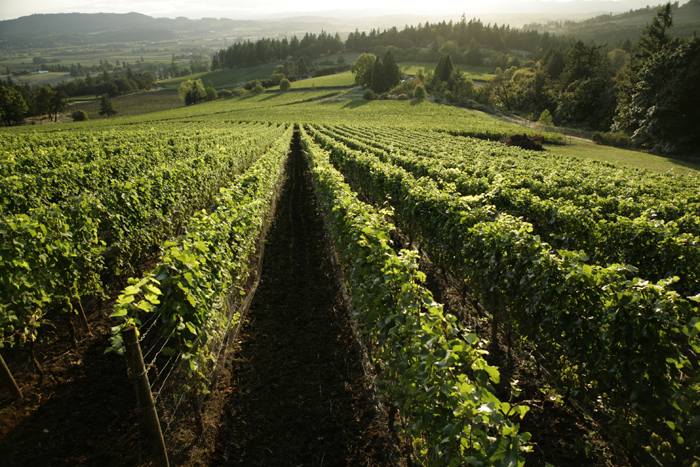 some real
battles to wage in order to protect the Willamette
Valley from sprawling residential growth.” In
fact, Adelsheim is credited with keeping Yamhill
County a vinicultural zone, now the center of the
state’s wine industry.
some real
battles to wage in order to protect the Willamette
Valley from sprawling residential growth.” In
fact, Adelsheim is credited with keeping Yamhill
County a vinicultural zone, now the center of the
state’s wine industry.
Still,
Oregon wineries had little focus until various
pioneers like Adelsheim, Dick Erath and David Lett
insisted that the varietal that had the greatest
potential in the terroirs of the Willamette Valley
was Pinot Noir—a belief proven correct when Lett’s
Eyrie Vineyards Pinot Noir bested top-tier French
Burgundies in two blind tastings in 1979. So
eye-opening were those match-ups that the
illustrious Burgundian vintner Joseph Drouhin
scoped out vineyards on Oregon and began plantings
there soon afterwards.
Meanwhile,
Adelsheim was spending his time
in Burgundy, learning its techniques and secrets;
he even became Burgundian Liason for the First
International Pinot Noir Festival, held in Oregon
in 1987. Adelsheim’s
acreage grew, as did its wine-making facilities.
In 1994 Jack and Lynn Loacker came on as
co-owners, adding further to their estate
holdings. With
the addition of winemaker David Paige in 2001, the
Adelsheim style of Pinot Noir was set, based on
finesse, elegance and harmony.
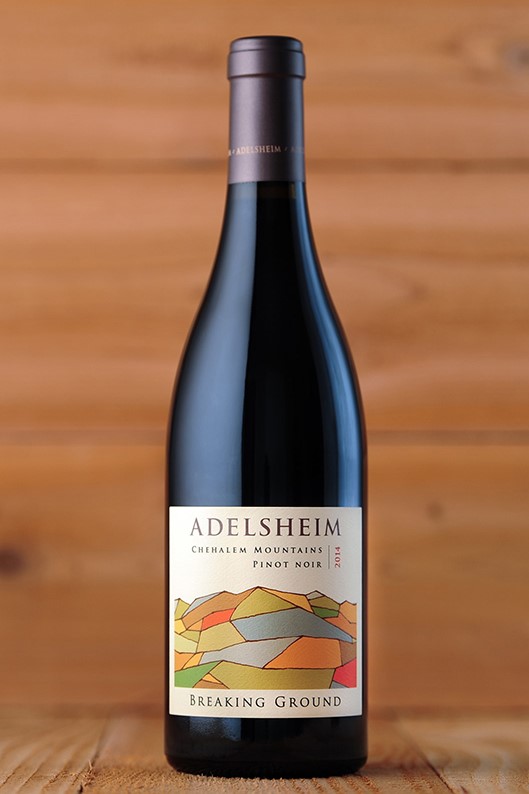 Yet, despite tremendous
strides—Oregon now has nearly 700 wineries and a
thriving wine tourism industry—production is still
way behind that of neighboring Washington State.
“Our relative size has always been a virtue and an
incentive in Oregon,” says Adelsheim. “Instead of
mere volume, Oregon vintners aim for high quality. Even if
I wanted to make one of those ultra-ripe
California-style Chardonnays, our climate wouldn’t
permit it, because we don’t get that kind of heat
in the Willamette Valley.” (Adelsheim does make
about 2,400 cases of Chardonnay [$65], with the
2014 at 13.5% alcohol.) “We could boost up the
alcohol percentages in our wines by letting the
grapes hang on the vine later in the season, but
we don’t aim for that style, especially with Pinot
Noir, which takes on a different flavor profile
when the alcohol gets above 14 percent.” His
2014 “Breaking Ground” Pinot Noir ($45)
comes in at 13.5%, with only 1,779 cases produced.
Adelsheim also makes a rosé from Pinot Noir ($25),
as well as a Pinot Gris ($19), Auxerrois ($25) and
Pinot Blanc ($25).
Yet, despite tremendous
strides—Oregon now has nearly 700 wineries and a
thriving wine tourism industry—production is still
way behind that of neighboring Washington State.
“Our relative size has always been a virtue and an
incentive in Oregon,” says Adelsheim. “Instead of
mere volume, Oregon vintners aim for high quality. Even if
I wanted to make one of those ultra-ripe
California-style Chardonnays, our climate wouldn’t
permit it, because we don’t get that kind of heat
in the Willamette Valley.” (Adelsheim does make
about 2,400 cases of Chardonnay [$65], with the
2014 at 13.5% alcohol.) “We could boost up the
alcohol percentages in our wines by letting the
grapes hang on the vine later in the season, but
we don’t aim for that style, especially with Pinot
Noir, which takes on a different flavor profile
when the alcohol gets above 14 percent.” His
2014 “Breaking Ground” Pinot Noir ($45)
comes in at 13.5%, with only 1,779 cases produced.
Adelsheim also makes a rosé from Pinot Noir ($25),
as well as a Pinot Gris ($19), Auxerrois ($25) and
Pinot Blanc ($25).
Oregon’s
milder temperatures have allowed winemakers to aim
for a balance of fruit and acid, as in the best
Burgundies, and Adelsheim is not as worried about
global warming in his vineyards as he is about
overall climate change, because “so many factors
go into what makes an individual terroir, and
climate is significant to every aspect of growing
grapes.” In 2007 Adelsheim and vineyard manager
Chad Vargas aimed to get all their estate vineyards
certified by LIVE (Low Input Viticulture and
Enology), a program founded in Oregon ten years
earlier and the first in the U.S. to be endorsed
by the International Organization for Biological
and Integrated Control of Noxious Animals and
Plants. In 2012 David Adelsheim received
the lifetime achievement award from the Oregon
Wine Board for lifetime of service in the
industry.
Adelsheim seems to have warmed
to the idea of expansion and making a good living
from wine, noting that “Our export market is
becoming more and more important for us because we
have a moral obligation to our winegrowers to
expand markets and help them make a good return on
their investment.”
In that regard, David, whose title is now
President, primarily focuses his energies on strategic planning, marketing and
sales, financial planning, and over-all direction
of vineyard and winemaking activities. Yet
he still remembers when it was his job to fix the
broken plumbing.
“I know this is a business,” said
David, “but it’s still a lot of hard work to make
it work, and for me it’s still a lot of fun.”
Which
is
where he came in.
❖❖❖
THOSE BANANA PEELS?
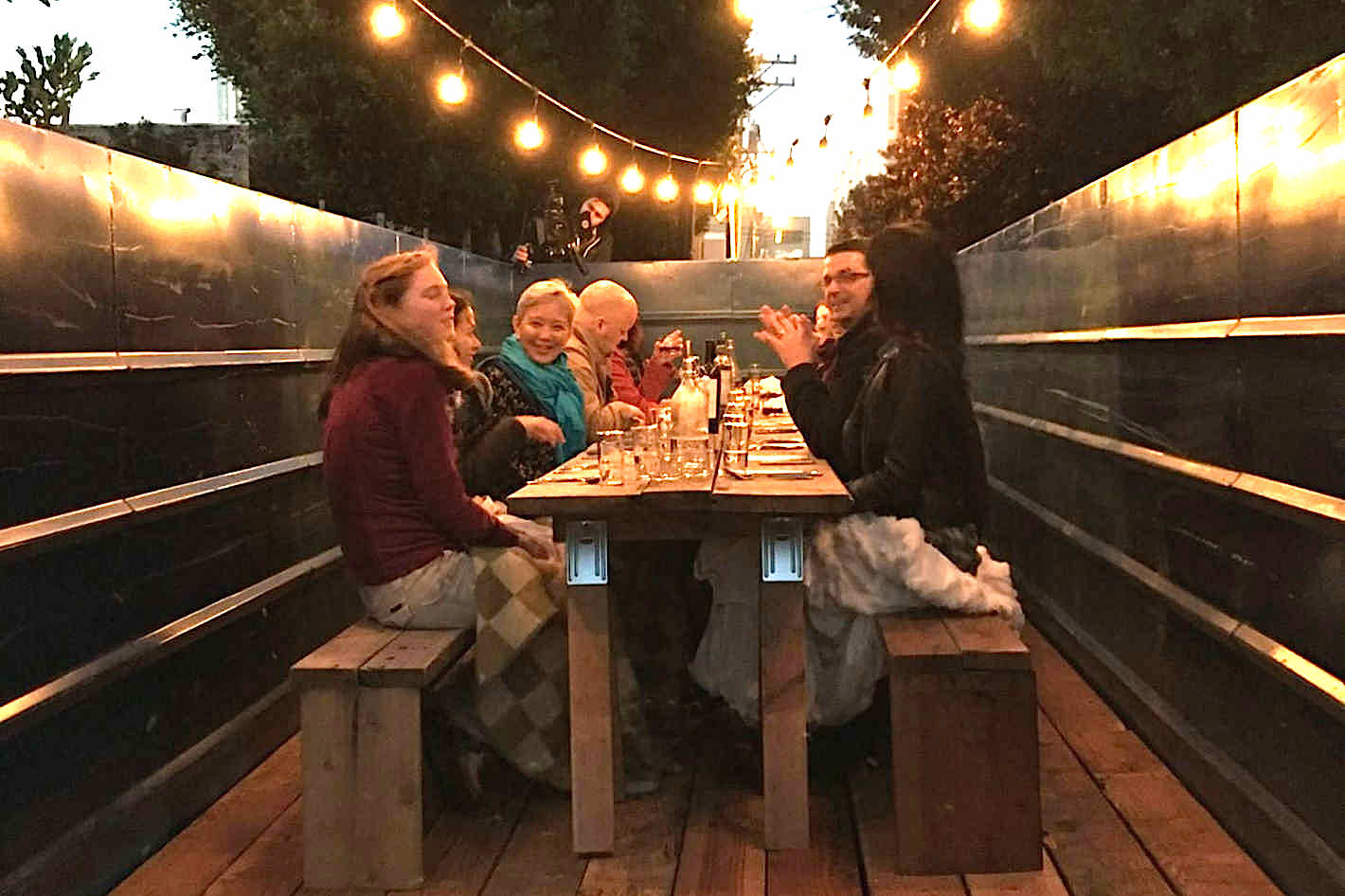
A group devoted to not wasting food named Salvage Supperclub is now hosting Dumpster-dinner series using recycled food from trash bins. A NPR reporter attended one San Francisco dinner (right) that consisted of wilted basil, bruised plums, past-their-prime tomatoes, vegetable pulp, surplus squash, whole favas, garbanzo bean water, dairy whey, sweet potato skins and overripe, peel-on bananas.
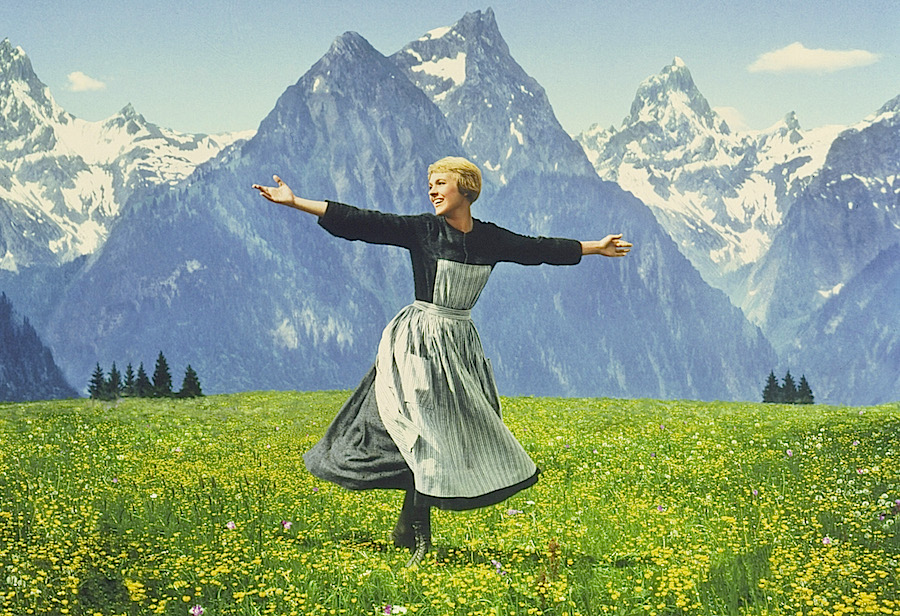
AND DID THE EARTH MOVE
FOR THEE, TOO?
“I first
learned that the world could be a wondrous place filled
with magical delights when, as a little girl in
Brooklyn, I walked up to a Good Humor truck. There, for
sale, was a stick of ice cream that has an entire
chocolate bar inside of it. Chocolate candy. Inside ice
cream. Are. You. Kidding. Me. Good Humor introduced me
to joy and awe.”—Liz Tuccillo, “My Life in Ice Cream,” Food & Wine
(August, 2016).
SPONSORED BY BANFI VINTNERS
Summer’s
Perfect
Pairing: Crab and Gavi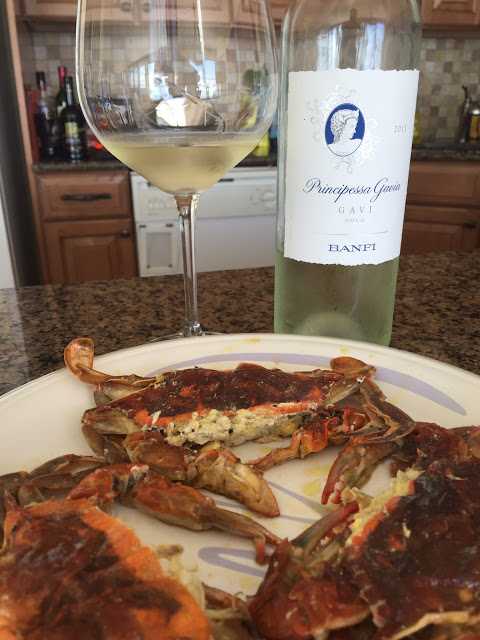
By John Fodera, TuscanVine.com
With the
unbearably hot and humid weather we’ve been
experiencing this summer in the Northeast, a quick
trip to New Jersey’s Long Beach Island was a
refreshing break for the body and soul – as well as a
delight to the taste buds. While Maryland may be more
famous for crabs, NJ’s bays supply similarly
scrumptious crustaceans, and the sweet, succulent
scallops caught off of LBI’s coast cannot be matched.
Fresh, local catch inspired this simple seaside
recipe.
~ Soft Shell
Crabs with lump crab meat, diver scallops and
rigatoni. This is decadence from the sea. ~
The recipe began by boiling
the pasta. Simultaneously, I sautéed the soft shells
in some lemon, white wine, and olive oil, and helped
myself to a crab as I cooked. Hey, chef's
preference! While
doing so, I opened a lovely white: 2015 Principessa
Gavia Gavi from Castello Banfi's Piedmont estate, an
excellent value from what is shaping up to be an
excellent 2015 vintage.
Made from 100% Cortese grapes grown in
Piemonte, the Gavi DOCG zone was promoted from DOC
status in 1998.
The nose of the wine is
replete with white flowers, peaches and citrus notes
that carry through on the palate but add a
distinctive, shale-like, minerally note that I love.
The crabs seemed to bring out a certain saline aspect
in the wine that was very mouthwatering and before I
knew it, almost half the bottle was gone before lunch! (Yes, it
was nap time on the beach afterwards.) Vinified
completely in stainless steel, this retains its
freshness from start to finish and is crisp, lively
and refreshing.
Any of John Mariani's books below may be ordered from amazon.com.
 The
Hound in Heaven (21st Century Lion Books)
is a novella, and for anyone who loves dogs,
Christmas, romance, inspiration, even the supernatural, I
hope you'll find this to be a treasured favorite.
The story concerns how, after a New England teacher,
his wife and their two daughters adopt a stray puppy found
in their barn in northern Maine, their lives seem full of
promise. But when tragedy strikes, their wonderful dog
Lazarus and the spirit of Christmas are the only things
that may bring his master back from the edge of
despair.
The
Hound in Heaven (21st Century Lion Books)
is a novella, and for anyone who loves dogs,
Christmas, romance, inspiration, even the supernatural, I
hope you'll find this to be a treasured favorite.
The story concerns how, after a New England teacher,
his wife and their two daughters adopt a stray puppy found
in their barn in northern Maine, their lives seem full of
promise. But when tragedy strikes, their wonderful dog
Lazarus and the spirit of Christmas are the only things
that may bring his master back from the edge of
despair. WATCH THE VIDEO!
“What a huge surprise turn this story took! I was completely stunned! I truly enjoyed this book and its message.” – Actress Ali MacGraw
“He had me at Page One. The amount of heart, human insight, soul searching, and deft literary strength that John Mariani pours into this airtight novella is vertigo-inducing. Perhaps ‘wow’ would be the best comment.” – James Dalessandro, author of Bohemian Heart and 1906.
“John Mariani’s Hound in Heaven starts with a well-painted portrayal of an American family, along with the requisite dog. A surprise event flips the action of the novel and captures us for a voyage leading to a hopeful and heart-warming message. A page turning, one sitting read, it’s the perfect antidote for the winter and promotion of holiday celebration.” – Ann Pearlman, author of The Christmas Cookie Club and A Gift for my Sister.
“John Mariani’s concise, achingly beautiful novella pulls a literary rabbit out of a hat – a mash-up of the cosmic and the intimate, the tragic and the heart-warming – a Christmas tale for all ages, and all faiths. Read it to your children, read it to yourself… but read it. Early and often. Highly recommended.” – Jay Bonansinga, New York Times bestselling author of Pinkerton’s War, The Sinking of The Eastland, and The Walking Dead: The Road To Woodbury.
“Amazing things happen when you open your heart to an animal. The Hound in Heaven delivers a powerful story of healing that is forged in the spiritual relationship between a man and his best friend. The book brings a message of hope that can enrich our images of family, love, and loss.” – Dr. Barbara Royal, author of The Royal Treatment.
 |
The Encyclopedia of American Food and Drink by John F. Mariani (Bloomsbury USA, $35) Modesty forbids me to praise my own new book, but let me proudly say that it is an extensive revision of the 4th edition that appeared more than a decade ago, before locavores, molecular cuisine, modernist cuisine, the Food Network and so much more, now included. Word origins have been completely updated, as have per capita consumption and production stats. Most important, for the first time since publication in the 1980s, the book includes more than 100 biographies of Americans who have changed the way we cook, eat and drink -- from Fannie Farmer and Julia Child to Robert Mondavi and Thomas Keller. "This book is amazing! It has entries for everything from `abalone' to `zwieback,' plus more than 500 recipes for classic American dishes and drinks."--Devra First, The Boston Globe. "Much needed in any kitchen library."--Bon Appetit. |
"Eating Italian will never be the same after reading John Mariani's entertaining and savory gastronomical history of the cuisine of Italy and how it won over appetites worldwide. . . . This book is such a tasteful narrative that it will literally make you hungry for Italian food and arouse your appetite for gastronomical history."--Don Oldenburg, USA Today. "Italian
restaurants--some good, some glitzy--far
outnumber their French rivals. Many of
these establishments are zestfully described
in How Italian Food Conquered the World, an
entertaining and fact-filled chronicle by
food-and-wine correspondent John F.
Mariani."--Aram Bakshian Jr., Wall Street
Journal.
"Equal parts
history, sociology, gastronomy, and just
plain fun, How Italian Food Conquered the
World tells the captivating and delicious
story of the (let's face it) everybody's
favorite cuisine with clarity, verve and
more than one surprise."--Colman Andrews,
editorial director of The Daily
Meal.com. "A fantastic and fascinating
read, covering everything from the influence
of Venice's spice trade to the impact of
Italian immigrants in America and the
evolution of alta cucina. This book will
serve as a terrific resource to anyone
interested in the real story of Italian
food."--Mary Ann Esposito, host of PBS-TV's
Ciao
Italia. "John Mariani has written the
definitive history of how Italians won their
way into our hearts, minds, and
stomachs. It's a story of pleasure over
pomp and taste over technique."--Danny Meyer,
owner of NYC restaurants Union Square
Cafe, The Modern, and Maialino.
|
 |
 |
 |
 |
 |
 |
 |
 |
 Everett Potter's Travel Report:
Everett Potter's Travel Report: 
 Eating Las Vegas
JOHN CURTAS has been covering the Las Vegas
food and restaurant scene since 1995. He is
the co-author of EATING LAS VEGAS – The 50
Essential Restaurants (the fourth
edition of which will be published in early
2016), as well as the author of the Eating Las
Vegas web site: www.eatinglasvegas.
He can also be seen every Friday morning as
the “resident foodie” for Wake Up With the
Wagners on KSNV TV (NBC) Channel 3 in
Las Vegas.
Eating Las Vegas
JOHN CURTAS has been covering the Las Vegas
food and restaurant scene since 1995. He is
the co-author of EATING LAS VEGAS – The 50
Essential Restaurants (the fourth
edition of which will be published in early
2016), as well as the author of the Eating Las
Vegas web site: www.eatinglasvegas.
He can also be seen every Friday morning as
the “resident foodie” for Wake Up With the
Wagners on KSNV TV (NBC) Channel 3 in
Las Vegas.

MARIANI'S VIRTUAL GOURMET
NEWSLETTER is published weekly. Editor/Publisher: John
Mariani.
Editor: Walter Bagley. Contributing Writers: Christopher Mariani,
Robert Mariani, Misha
Mariani,
John A. Curtas, Edward Brivio, Mort Hochstein,
Andrew Chalk, Dotty Griffith and Brian Freedman. Contributing
Photographers: Galina Dargery, Bobby
Pirillo. Technical Advisor: Gerry McLoughlin.
To un-subscribe from this newsletter,click here.
© copyright John Mariani 2016

